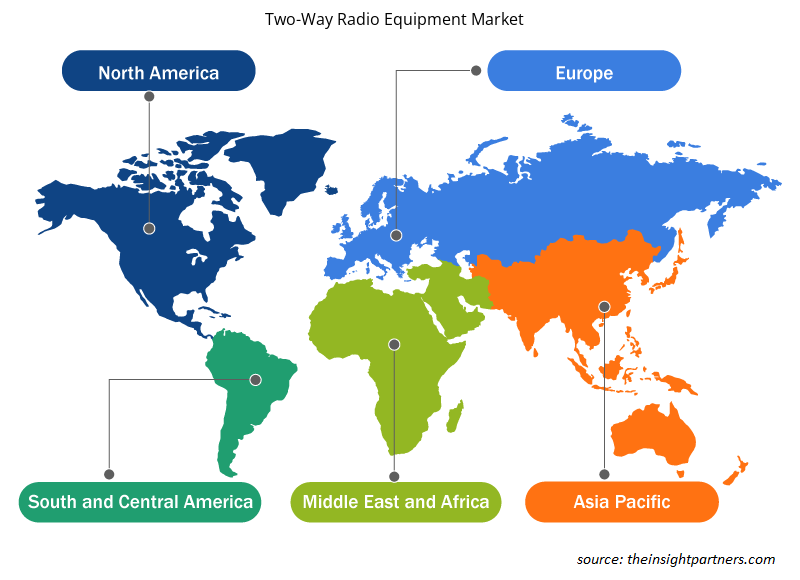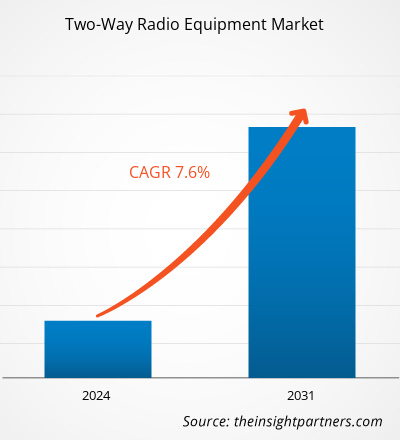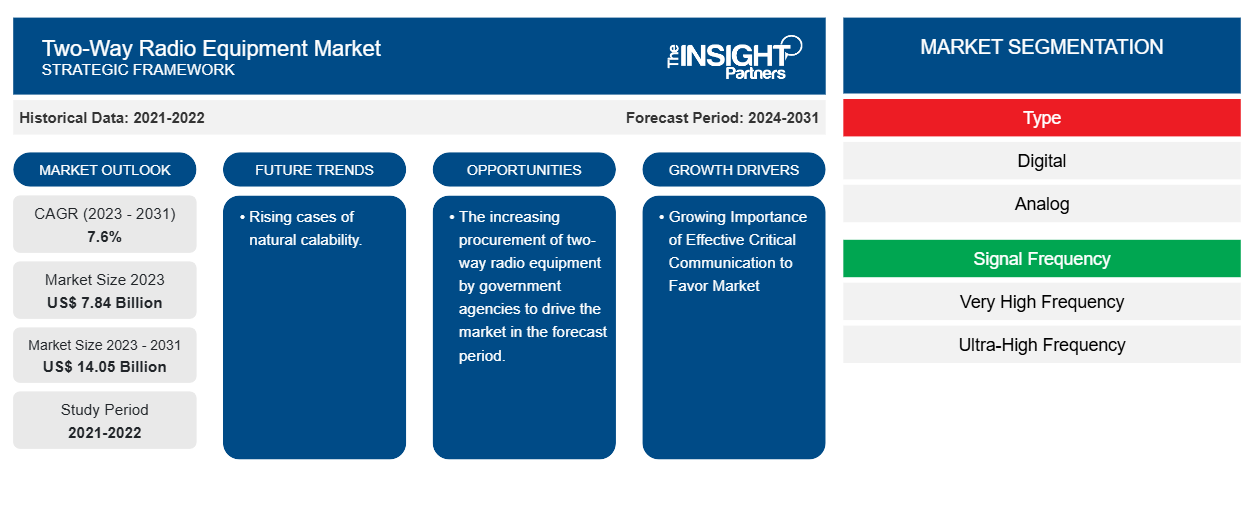من المتوقع أن يصل حجم سوق معدات الراديو ثنائية الاتجاه إلى 14.05 مليار دولار أمريكي بحلول عام 2031 من 7.84 مليار دولار أمريكي في عام 2023. ومن المتوقع أن يسجل السوق معدل نمو سنوي مركب بنسبة 7.6٪ خلال الفترة 2023-2031. ومن المرجح أن يكون التبني المتزايد للراديو الرقمي ثنائي الاتجاه على المعدات التناظرية والطلب المتزايد على معدات الراديو ثنائية الاتجاه في تصنيع أجهزة الاستشعار من المحركات والاتجاهات الرئيسية للسوق.
تحليل سوق معدات الاتصال اللاسلكي ثنائية الاتجاه
يشهد سوق معدات الاتصال اللاسلكي ثنائي الاتجاه نموًا كبيرًا على مستوى العالم. ويعزى هذا النمو إلى عوامل مثل التبني المتزايد للاتصال اللاسلكي ثنائي الاتجاه الرقمي على المعدات التناظرية والطلب المتزايد على معدات الاتصال اللاسلكي ثنائي الاتجاه في تصنيع أجهزة الاستشعار. وعلاوة على ذلك، من المتوقع أن يؤدي زيادة شراء معدات الاتصال اللاسلكي ثنائي الاتجاه من قبل الوكالات الحكومية إلى دفع نمو السوق في السنوات القادمة.
نظرة عامة على سوق معدات الاتصال اللاسلكي ثنائية الاتجاه
يعتبر جهاز الراديو ثنائي الاتجاه جهاز إرسال واستقبال لاسلكي. يمكن لهذا الجهاز اللاسلكي أن يتواصل ويستقبل موجات الراديو، والتي تُستخدم في الاتصال الصوتي ثنائي الاتجاه من شخص إلى شخص مع مستخدمين آخرين بأجهزة راديو مماثلة، على عكس جهاز الاستقبال الإذاعي، الذي يستقبل الإرسال فقط. تستخدم أجهزة الراديو ثنائية الاتجاه عادةً قناة اتصال نصف مزدوجة، مما يسمح بالاتصال ثنائي الاتجاه، على الرغم من وجود قيد مفاده أنه لا يمكن إلا لمستخدم واحد الإرسال في المرة الواحدة.
قم بتخصيص هذا التقرير ليناسب متطلباتك
ستحصل على تخصيص لأي تقرير - مجانًا - بما في ذلك أجزاء من هذا التقرير، أو تحليل على مستوى الدولة، وحزمة بيانات Excel، بالإضافة إلى الاستفادة من العروض والخصومات الرائعة للشركات الناشئة والجامعات
-
احصل على أهم اتجاهات السوق الرئيسية لهذا التقرير.ستتضمن هذه العينة المجانية تحليلاً للبيانات، بدءًا من اتجاهات السوق وحتى التقديرات والتوقعات.
محركات وفرص سوق معدات الاتصال اللاسلكي ثنائية الاتجاه
الأهمية المتزايدة للتواصل النقدي الفعال لصالح السوق.
إن الأهمية المتزايدة للاتصالات الحرجة الفعّالة هي التي تدفع السوق بالفعل. لقد تطورت تقنية الاتصال اللاسلكي ثنائي الاتجاه من الصوت التناظري التقليدي إلى أنظمة معقدة ذات إمكانيات ربط ورقمية تمكن ميزات مثل الاتصال الجماعي وإعداد مكالمة صوتية سريعة وصوت عالي الجودة ووصول مضمون للمستخدم النهائي. مع زيادة الجريمة والإرهاب والكوارث الطبيعية، أصبحت الصناعات مطالبة بتبني تقنيات جديدة لتمكين ردود الفعل السريعة والفعّالة في الوقت الفعلي. يعد الاتصال الفعّال أمرًا بالغ الأهمية لمستجيبي السلامة العامة الذين يجب أن يظلوا على اتصال في مركز التحكم مع اكتساب معلومات ظرفية في الوقت الفعلي عند الاستجابة للمواقف.
ارتفاع حالات قابلية التوسع الطبيعية.
لقد أدت حالات الكوارث الطبيعية المتزايدة، بما في ذلك الأعاصير والزلازل وحرائق الغابات والفيضانات، إلى زيادة الطلب بشكل كبير على أنظمة الصوت الموثوقة، وبالتالي تعمل كمحرك لسوق معدات الراديو ثنائية الاتجاه. في سبتمبر 2023، وفقًا للإدارة الوطنية للمحيطات والغلاف الجوي، عانت الولايات المتحدة من 23 كارثة مناخية ومناخية ضخمة منفصلة أدت كل منها إلى أضرار لا تقل عن مليار دولار أمريكي. خلال مثل هذه الكوارث الطبيعية، غالبًا ما تتعطل البنى التحتية للاتصالات التقليدية مثل الشبكات الخلوية والاتصال بالإنترنت بسبب البنية التحتية التالفة أو التحميل الزائد. في مثل هذه المواقف، يعتمد المستجيبون للطوارئ والوكالات الحكومية ومنظمات الإغاثة بشكل كبير على الراديو ثنائي الاتجاه للاتصالات الحرجة، حيث توفر قدرات اتصال قوية ومرنة.
تقرير تحليلي لتجزئة سوق معدات الاتصال اللاسلكي ثنائي الاتجاه
إن القطاعات الرئيسية التي ساهمت في اشتقاق تحليل سوق معدات الراديو ثنائية الاتجاه هي النوع وتردد الإشارة وصناعة الاستخدام النهائي.
- وفقًا للنوع، يتم تقسيم سوق معدات الاتصال اللاسلكي ثنائي الاتجاه إلى رقمية وتناظرية. ومن المتوقع أن يحظى القطاع الرقمي بحصة سوقية كبيرة خلال فترة التوقعات.
- بناءً على تردد الإشارة، يتم تقسيم سوق معدات الراديو ثنائية الاتجاه إلى تردد عالي جدًا (VHF) وتردد فائق الارتفاع (UHF). ومن المتوقع أن يحظى قطاع التردد العالي جدًا (VHF) بحصة سوقية كبيرة في فترة التوقعات.
- من خلال صناعة الاستخدام النهائي ، يتم تقسيم السوق إلى قطاعات الحكومة والسلامة العامة، والتصنيع، والمرافق، والنقل والخدمات اللوجستية، والتعليم، والضيافة، وغيرها. ومن المتوقع أن يستحوذ قطاع الحكومة والسلامة العامة على حصة سوقية كبيرة في الفترة المتوقعة.
تحليل حصة سوق معدات الاتصال اللاسلكي ثنائي الاتجاه حسب المنطقة الجغرافية
ينقسم النطاق الجغرافي لتقرير سوق معدات الراديو ثنائية الاتجاه بشكل أساسي إلى خمس مناطق: أمريكا الشمالية، ومنطقة آسيا والمحيط الهادئ، وأوروبا، والشرق الأوسط وأفريقيا، وأمريكا الجنوبية والوسطى.
سيطرت أمريكا الشمالية على سوق معدات الاتصال اللاسلكي ثنائي الاتجاه. وقد أدت اتجاهات تبني التكنولوجيا العالية في مختلف الصناعات في منطقة أمريكا الشمالية إلى تغذية نمو سوق معدات الاتصال اللاسلكي ثنائي الاتجاه. ومن المتوقع أن تؤدي عوامل مثل زيادة اعتماد الأدوات الرقمية والإنفاق التكنولوجي العالي من قبل الوكالات الحكومية إلى دفع نمو سوق معدات الاتصال اللاسلكي ثنائي الاتجاه في أمريكا الشمالية. إن التبني المتزايد للراديو الرقمي ثنائي الاتجاه على المعدات التناظرية والطلب المتزايد على معدات الاتصال اللاسلكي ثنائي الاتجاه في تصنيع أجهزة الاستشعار. علاوة على ذلك، فإن التركيز القوي على البحث والتطوير في الاقتصادات المتقدمة في الولايات المتحدة وكندا يجبر اللاعبين في أمريكا الشمالية على جلب حلول متقدمة تقنيًا إلى السوق. بالإضافة إلى ذلك، تمتلك الولايات المتحدة عددًا كبيرًا من اللاعبين في سوق معدات الاتصال اللاسلكي ثنائي الاتجاه الذين يركزون بشكل متزايد على تطوير حلول مبتكرة. تساهم كل هذه العوامل في نمو سوق معدات الاتصال اللاسلكي ثنائي الاتجاه في المنطقة.
رؤى إقليمية حول سوق معدات الاتصال اللاسلكي ثنائي الاتجاه
لقد قام المحللون في Insight Partners بشرح الاتجاهات والعوامل الإقليمية المؤثرة على سوق معدات الاتصال اللاسلكي ثنائي الاتجاه طوال فترة التوقعات بشكل شامل. يناقش هذا القسم أيضًا قطاعات سوق معدات الاتصال اللاسلكي ثنائي الاتجاه والجغرافيا في جميع أنحاء أمريكا الشمالية وأوروبا ومنطقة آسيا والمحيط الهادئ والشرق الأوسط وأفريقيا وأمريكا الجنوبية والوسطى.

- احصل على البيانات الإقليمية المحددة لسوق معدات الراديو ثنائية الاتجاه
نطاق تقرير سوق معدات الاتصال اللاسلكي ثنائي الاتجاه
| سمة التقرير | تفاصيل |
|---|---|
| حجم السوق في عام 2023 | 7.84 مليار دولار أمريكي |
| حجم السوق بحلول عام 2031 | 14.05 مليار دولار أمريكي |
| معدل النمو السنوي المركب العالمي (2023 - 2031) | 7.6% |
| البيانات التاريخية | 2021-2022 |
| فترة التنبؤ | 2024-2031 |
| القطاعات المغطاة |
حسب النوع
|
| المناطق والدول المغطاة |
أمريكا الشمالية
|
| قادة السوق وملفات تعريف الشركات الرئيسية |
|
كثافة اللاعبين في سوق معدات الاتصال اللاسلكي ثنائي الاتجاه: فهم تأثيرها على ديناميكيات الأعمال
يشهد سوق معدات الراديو ثنائية الاتجاه نموًا سريعًا، مدفوعًا بالطلب المتزايد من المستخدم النهائي بسبب عوامل مثل تفضيلات المستهلك المتطورة والتقدم التكنولوجي والوعي الأكبر بفوائد المنتج. ومع ارتفاع الطلب، تعمل الشركات على توسيع عروضها والابتكار لتلبية احتياجات المستهلكين والاستفادة من الاتجاهات الناشئة، مما يؤدي إلى زيادة نمو السوق.
تشير كثافة اللاعبين في السوق إلى توزيع الشركات أو المؤسسات العاملة في سوق أو صناعة معينة. وهي تشير إلى عدد المنافسين (اللاعبين في السوق) الموجودين في مساحة سوق معينة نسبة إلى حجمها أو قيمتها السوقية الإجمالية.
الشركات الرئيسية العاملة في سوق معدات الراديو ثنائية الاتجاه هي:
- شركة بي كيه للتكنولوجيا
- مجموعة بيركوم المحدودة
- شركة هايتيرا للاتصالات المحدودة
- شركة ايكوم امريكا
- شركة راديو ميدلاند
- شركة موتورولا سوليوشنز
إخلاء المسؤولية : الشركات المذكورة أعلاه ليست مرتبة بأي ترتيب معين.

- احصل على نظرة عامة على أهم اللاعبين الرئيسيين في سوق معدات الاتصال اللاسلكي ثنائية الاتجاه
أخبار سوق معدات الاتصال اللاسلكي ثنائية الاتجاه والتطورات الأخيرة
يتم تقييم سوق معدات الاتصال اللاسلكي ثنائي الاتجاه من خلال جمع البيانات النوعية والكمية بعد البحث الأولي والثانوي، والتي تتضمن منشورات الشركات المهمة وبيانات الجمعيات وقواعد البيانات. فيما يلي بعض التطورات في سوق معدات الاتصال اللاسلكي ثنائي الاتجاه:
- أطلقت شركة Hytera Communications، إحدى الشركات العالمية الرائدة في توفير تقنيات وحلول الاتصالات الاحترافية، مؤخرًا أحدث سلسلة من أجهزة الراديو الآمنة جوهريًا (IS)، بما في ذلك جهاز الراديو المحمول ثنائي الاتجاه HP79XEx DMR وجهاز الراديو المحمول PT890Ex TETRA. (المصدر: موقع شركة Hytera Communications على الويب، نوفمبر 2023)
- أعلنت شركة موتورولا سوليوشنز عن إطلاق جهاز MOTOTRBO R7 في أوروبا والشرق الأوسط وأفريقيا. يوفر جهاز الراديو الرقمي الجديد ثنائي الاتجاه ميزات صوتية متقدمة وتصميمًا نحيفًا وقويًا لربط الفرق في البيئات الصاخبة والخشنة والديناميكية. (المصدر: موقع شركة موتورولا سوليوشنز، أبريل 2022)
تقرير سوق معدات الاتصال اللاسلكي ثنائي الاتجاه والتغطية والنتائج المتوقعة
يوفر تقرير "حجم سوق معدات الاتصال اللاسلكي ثنائي الاتجاه والتوقعات (2021-2031)" تحليلاً مفصلاً للسوق يغطي المجالات التالية:
- حجم سوق معدات الاتصال اللاسلكي ثنائي الاتجاه وتوقعاته على المستويات العالمية والإقليمية والوطنية لجميع قطاعات السوق الرئيسية التي يغطيها النطاق
- اتجاهات سوق معدات الاتصال اللاسلكي ثنائية الاتجاه بالإضافة إلى ديناميكيات السوق مثل العوامل المحركة والقيود والفرص الرئيسية
- تحليل مفصل لقوى PEST/Porter الخمس وSWOT
- تحليل سوق معدات الاتصال اللاسلكي ثنائي الاتجاه يغطي اتجاهات السوق الرئيسية والإطار العالمي والإقليمي والجهات الفاعلة الرئيسية واللوائح والتطورات الأخيرة في السوق
- تحليل المشهد الصناعي والمنافسة الذي يغطي تركيز السوق، وتحليل خريطة الحرارة، واللاعبين البارزين، والتطورات الأخيرة لسوق معدات الراديو ثنائية الاتجاه
- ملفات تعريف الشركة التفصيلية
- التحليل التاريخي (سنتان)، سنة الأساس، التوقعات (7 سنوات) مع معدل النمو السنوي المركب
- تحليل PEST و SWOT
- حجم السوق والقيمة / الحجم - عالمي، إقليمي، بلد
- الصناعة والمنافسة
- مجموعة بيانات إكسل
التقارير الحديثة
تقارير ذات صلة
شهادات العملاء
سبب الشراء
- اتخاذ قرارات مدروسة
- فهم ديناميكيات السوق
- تحليل المنافسة
- رؤى العملاء
- توقعات السوق
- تخفيف المخاطر
- التخطيط الاستراتيجي
- مبررات الاستثمار
- تحديد الأسواق الناشئة
- تحسين استراتيجيات التسويق
- تعزيز الكفاءة التشغيلية
- مواكبة التوجهات التنظيمية























 احصل على عينة مجانية ل - سوق معدات الاتصال اللاسلكي ثنائية الاتجاه
احصل على عينة مجانية ل - سوق معدات الاتصال اللاسلكي ثنائية الاتجاه